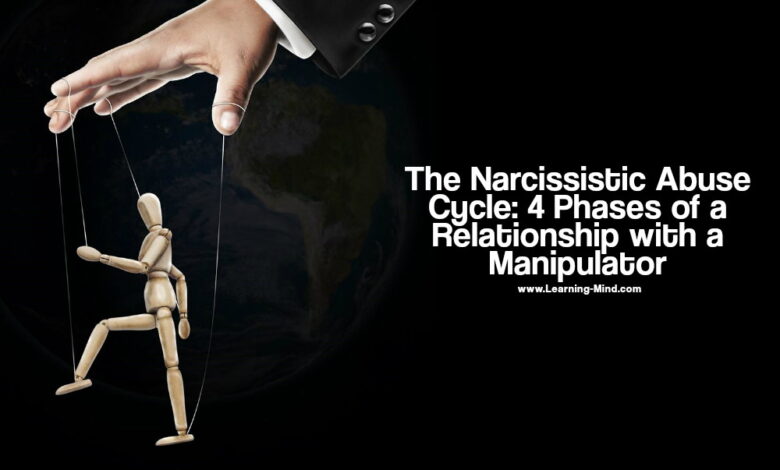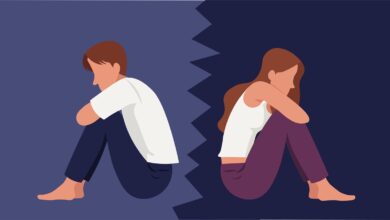
The Narcissistic Abuse Cycle: 4 Phases of a Relationship with a Manipulator
No one purposefully enters into a narcissistic relationship. We like people that make us feel good about ourselves. We are drawn to those who are friendly, generous and gregarious. We are programmed by evolution to be attracted to people that share common interests.
And it is exactly these qualities that narcissists use to ensnare their victims. After all, showing their true self at the start of a relationship would doom it to failure.
The narcissistic abuse cycle follows four distinct stages: tension building, a violent incident, a period of forgiveness and then calm, until it repeats itself.
I want to explore these phases of abuse from narcissists in more detail.
4 Phases of Narcissistic Abuse Cycle
US psychologist Lenore Walker founded the Domestic Abuse Institute. In 1979, after interviewing over 1000 domestic abuse victims, she identified a pattern of behaviour she called the ‘cycle of abuse’. These stages can be seen in a narcissistic relationship.
This abuse follows four distinct phases:
- Tension builds in the relationship
- An abusive incident occurs
- Reconciliation/Forgiveness
- Calm
1. Tension
During the tension phase, the narcissist begins to devalue their partner. Far from being the ideal couple at the start of the relationship, the victim is now viewed as worthless. In this stage, the victim will start to notice a change in the narcissist’s behaviour. The perpetrator will behave in certain ways:
- Provoke arguments
- Sulk over trivial matters
- Criticising and insulting behaviour
- Use silent treatment
- Explode over nothing
- Accusatory behaviour
- Withhold affection/sex
- Make unreasonable demands
During this time, the victim will be constantly aware of the escalating tension. Their life will consist of treading on eggshells. They will try and anticipate the narcissists’ mood which will be impossible to predict.
As a result of the obvious tension-building phase, the victim will begin to adjust their behaviour. They will try placatory techniques to diffuse the situation. They have learned in the past that reasoning doesn’t work with a narcissist because their behaviour makes no sense.
The victim will become quiet and unobtrusive; putting their wants and needs last to avoid a showdown.
2. The Incident
Eventually, the tension builds to such an extent that it explodes into a verbal or physical incident. The narcissist lashes out at their partner after days, weeks or even months of living with increasing tension.
Partners of narcissists are ‘punished’ for some unknown slight they have no knowledge about. Incidents of verbal, physical or psychological abuse are designed to further diminish the victim’s resolve and strength.
Typically, during the narcissist relationship cycle, verbal outbursts and psychological abuse will target the character of the victim. They will be told they are worthless, that no one else would ever have them, that they are lucky they put up with them.
They will also be blamed for the outburst. It will be the victim’s fault that this incident had to happen.
3. Forgiveness
After the abusive incident, the abuser will do one or several of the following:
- Say they are sorry
- Ask for forgiveness
- Promise it will never happen again
- Shower the victim with love
- Ignore the incident
- Buy the victim gifts
- Deny the incident happened
- Blame the victim for their actions
- Threaten self-harm or suicide
At this point, the victim is in disbelief at what has just occurred. If this is the first time the narcissist has abused them, they will feel confused and even responsible for what has happened.
However, if this is part of the narcissist’s cycle of abuse, they may feel relief that the tension is over. They have come to know what to expect. They know that for now, at least, they are safe. The victim can now take time to recover from the incident.
This narcissistic relationship cycle of abuse continues depending on the perpetrator. Does the narcissist need something from their partner? Are they afraid they are going to be left alone? If the narcissist has no use for their partner, they will discard them and move onto another victim who can fulfill their needs.
4. Calm
If the narcissist is not finished with their partner, the cycle of abuse continues. Now follows a period of calm, where the abuse is never mentioned as if it didn’t happen. The narcissist doesn’t bring it up, and the victim is happy to forget about it.
It is during this stage that the relationship returns to some kind of normality. The narcissist begins the honeymoon stage again. Their partner is relieved that things seem to be back to normal. However, in reality, the narcissistic abuse cycle is about to begin again.
The victims of narcissistic abuse are so desperate to hang onto this idea of a wonderful relationship that they will do anything, even significantly change their behaviour.
An important factor to remember about this kind of narcissistic relationship cycle is that the victim is mentally worn down with each cycle that occurs. The constant mixed messages and actions have a detrimental effect on their mental well-being and identity.
Gradually, the tension starts to build again and the narcissistic cycle of abuse begins once more.
How to Avoid a Narcissistic Cycle of Abuse
Narcissists follow the same pattern of abuse. However, they can only start this cycle of abuse once you are firmly entrenched in a relationship with them. Understanding how narcissists entrap their victims is the key to avoiding an abusive relationship in the first place.
Before I start, it is prudent to say that not all abusive relationships are the same. For example, criminologist Dr. Jane Monkton-Smith recognises an 8-step pattern of escalating violent behaviour in domestic abuse situations. But as the term suggests, this cycle of abuse by narcissists is a pattern of repeating behaviour, not necessarily escalating.
While it is true that violent incidents in narcissistic relationships may increase over time, the cycle of behaviour stays the same.
The Honeymoon Phase
To begin with, narcissists ensnare their victims using manipulative techniques such as love bombing. Narcissists lure their victims by being ultra-charming, declaring true love after only a matter of weeks, even days.
This period of idealisation is the honeymoon phase. The target is made to feel special and wanted. The narcissist tells them they have never felt this way before. Their target is bombarded with love and attention that feels too good to be true.
In the early stages, narcissists put their partners on a pedestal and make them believe that they don’t need anyone else.
The Isolation/Control Phase
Once isolated, narcissists begin to exert more and more control. They may start restricting finances, questioning where their partners go, and who they see. They’ll obsessively check up on their partner, turning up at work unexpectedly and calling to see where they are.
As part of the narcissistic abuse cycle, the narcissist wants their partner completely dependent on them and them alone. The victim may start to believe something isn’t quite right. However, they will be manipulated into thinking they are at fault.
At this point, the narcissist will use manipulative techniques such as gaslighting. They want their victim off-balance, doubting their reality and worried about their sanity.
Now fully dependent and isolated, the narcissist can begin the true cycle of abuse. Currently, their partner is totally invested in the relationship, believing it to be a magical fairy-tale romance of a story. In reality, it is the start of a nightmare that is extremely difficult to extricate oneself from.
Are You about to Enter a Narcissistic Relationship?
Ask yourself the following:
- Is this new partner urging you to enter into a relationship too quickly?
- Are they declaring true love after a short period of time?
- Are they putting you on a pedestal without knowing you?
- Do they want to move in with you after a few weeks?
- Are they discussing marriage or children?
- Have they never felt this way about anyone before?
- Do you feel overwhelmed by their declarations of love?
- Are things moving too fast for you?
If the above feels familiar, it is advisable to step back from any relationship. Give yourself breathing space. As with most things in life, if something or someone seems too good to be true, they usually are.
Final thoughts
Recovering from a narcissistic abuse cycle takes time. Narcissists are master manipulators and prey on their victim’s weaknesses. You are not the person the narcissist claimed you to be. Spending time with family and loyal friends will raise your self-esteem and reconfirm your identity.
References:




